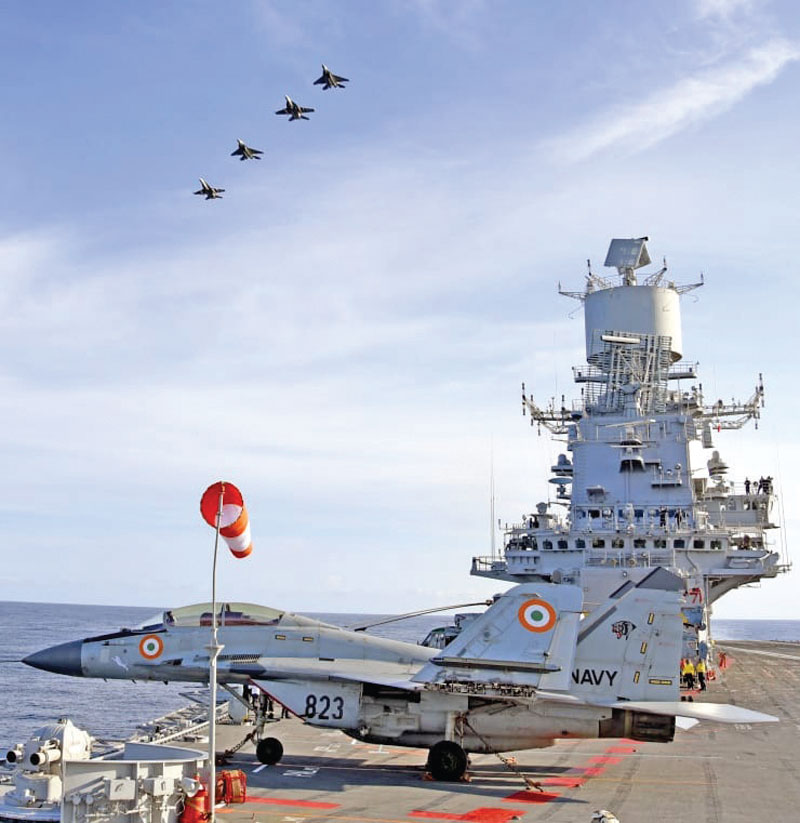With IAC-I starting sea trials soon, navy needs to finalise the fighters
Smruti D
Naval aviation, which is typically carried out from land bases or aircraft carrier, is the use of air power by navies. Naval aviation makes it possible for navies to dominate the waters in which they are operating.

However, given the cost involved in building, operating and maintaining a carrier group, there has been debate about the value for money that naval aviation gives to the operating navies. This debate is centred on the idea of dominance versus denial—with former being provided by an aircraft carrier and the latter by submarines.
According to Rear Admiral Sudhir Pillai (retd) former Flag Officer Naval Aviation, while talking to FORCE about the importance of naval aviation says that when navies go with aircraft to sea, there is a very specific intent. That specific intent is primarily Air Defence of the force. But they are also used for shore and ship strike under certain circumstances. He adds, “Many would tend to say that you can carry out these strikes and even defend naval forces using missiles and weaponry. Naval battles are fought and won, with each such weapon system, including manned aviation, being integral to ships and operations at sea.”
About whether he thinks aircraft carriers are a necessity, vis a vis large costs, he says that the costs of the aircraft are debatable issues. “In many ways they are a very cost-effective way of taking aviation to sea, to the far reaches of oceans, and for enabling sustained presence and effects, under diverse circumstances. Such capacities and capabilities indeed come at a cost but the result is strategic and operational efficacy.”
India currently operates the Russian-made INS Vikramaditya along with the MiG-29K aircraft. The carrier was inducted in 2014 and the total cost of the carrier as well as platform went up to USD7 billion. As the aircraft carrier is costly, CDS Bipin Rawat has recently said that India may shelve the plans to build a new aircraft carrier, which is the IAC-2, and instead build more submarines. However, naval experts believe that no comparison can be drawn between an aircraft carrier and submarines. Former Navy Chief Admiral Arun Prakash had said that the comparison between the naval platforms was like comparing ‘apples and oranges’.
India’s new aircraft carrier, Indigenous Aircraft Carrier 1 (IAC-1) is being built by the Cochin Shipyard. It is estimated to be inducted into the Indian Navy by 2022. In October, the navy started with the carrier’s basin trials. INS Vikrant was designed by the Directorate of Naval Design. The carrier is powered by four General Electric LM2500+ gas turbines driving two shafts. It can reach a top speed of 52 km/hour with a maximum range of 8,000 nautical miles. The ship has a displacement weight of 45,000 tonnes and can carry about 1,600 personnel including the air crew. INS Vikrant will have a capacity for 36-40 aircraft including 26 Russian-made MiG29 K. With a length of 260 metres, the warship will have two take-off runways and a landing strip with three arrester wires to operate STOBAR (short take-off barrier arrested recovery) aircraft.
As of now, India has only 45 MiG-29K fighters, which are also deployed on INS Vikramaditya. There have been concerns of shortage of aircraft. Technology and design wise, both of these carriers have the STOBAR system. This system is used for launch and recovery of an aircraft from the deck of the carrier. In this system, the aircraft are launched by a way of ‘ski-jump’, to assist the take off. The landing, known as arrestor recovery, is done by deploying two wires, laid a few metres apart from one another, on the landing platform. The aircraft, while landing, gets hooked on to the wire. Such landing is done where the runway space is limited.
INS Vikramaditya and under-construction INS Vikrant, have a similar design. Both of these carriers have a runway curved upwards. MiG-29Ks, being Russian, suit both these platforms. Incidentally, the design for IAC-II, currently on the drawing board, follows western design philosophy of a flat-top carrier. It will use a different system for take-off, called CATOBAR (catapult assisted take-off barrier arrested recovery), which uses catapult for take-off assisted by the electromagnetic launch system (EMALS). This system is known to be more complex and costly. This is a favoured technology as it enables carrying of heavier aircraft, including the airborne early warning aircraft. The Nimitz-class aircraft carrier that participated in Malabar exercise recently has the CATOBAR system. As envisaged by its designers, IAC-II will have the capacity to operate almost 80 aircraft.
Coming back to the current programme, Rear Admiral Pillai says, “The MiG 29Ks, have been adapted for carrier-borne usage and such aircraft could fall short of the effectiveness that dedicated naval fighters custom-built for such purposes bring to the role. There may be good reasons why the Navy has been looking for a replacement fighter aircraft for its next generation carriers. For the time being, MiG 29Ks and INS Vikramaditya will fill an interim requirement, with INS Viraat and Sea Harrier aircraft having been decommissioned, and till the next generation carrier and her aircraft are inducted.”
You must be logged in to view this content.

